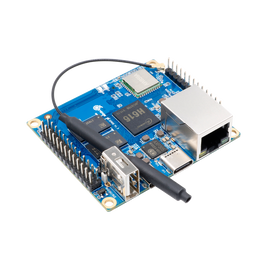NixOS on ARM/Orange Pi Zero2 H616: Difference between revisions
imported>Ein-shved Created page with "{{ARM/breadcrumb}} <div class="infobox"> {|class="table" !colspan="2" class="title"|Orange Pi Zero2 (H616) |- |colspan="2"|File:Orange-pi-zero-two-h616.png|frameless|256px|A..." |
imported>Ein-shved No edit summary |
||
| Line 22: | Line 22: | ||
== Status == | == Status == | ||
Upstream unstable NixOS AArch64 image will boot on the Orange Pi Zero2 (H616), using the proper upstream u-boot. | Upstream unstable NixOS AArch64 image will boot on the Orange Pi Zero2 (H616), using the proper upstream u-boot. | ||
The support of allwiner H616 soc was introduced to the Linux upstream kernel since 6.0 version, but the 5.15.78 kernel still able to boot from unstable NixOS brunch. | |||
== Board-specific installation notes == | == Board-specific installation notes == | ||
Revision as of 22:07, 15 November 2022
| Orange Pi Zero2 (H616) | |
|---|---|

| |
| Manufacturer | Xunlong / Orange Pi |
| Architecture | AArch64 |
| Bootloader | Upstream u-boot[1] |
| Maintainer | Ein-shved |
Status
Upstream unstable NixOS AArch64 image will boot on the Orange Pi Zero2 (H616), using the proper upstream u-boot.
The support of allwiner H616 soc was introduced to the Linux upstream kernel since 6.0 version, but the 5.15.78 kernel still able to boot from unstable NixOS brunch.
Board-specific installation notes
Fastest way
First follow the generic installation steps to get the installer image on an SD card.
U-Boot needs to be copied to specific sectors on the microSD card with dd. Download u-boot for the board, and copy it to the correct location with (again, replace /dev/sdX with the correct path to the SD card device):
sudo dd if=u-boot-sunxi-with-spl.bin of=/dev/sdX bs=1024 seek=8
Then, install using the installation and configuration steps.
Better way
You can use next flake to prepare ready-to-work image
{
description = "Build image for Orange Pi Zero2 H616";
inputs.nixpkgs.url = github:nixos/nixpkgs;
outputs = { self, nixpkgs }: rec {
# Better to avoid cross-compiling to
# download derivations from cache
system = "aarch64-linux";
nixosConfigurations.orpiz2 = nixpkgs.lib.nixosSystem rec {
system = "aarch64-linux";
modules = [
# Based on generic aarch64 image
"${nixpkgs}/nixos/modules/installer/sd-card/sd-image-aarch64.nix"
{
config = let
# Appropriate bootloader
bootloader = nixpkgs.legacyPackages.
aarch64-linux.ubootOrangePiZero2;
in {
system.stateVersion = "22.11";
# Use the supported kernel
boot.kernelPackages = nixpkgs.legacyPackages.
aarch64-linux.linuxKernel.packages.linux_6_0;
sdImage.postBuildCommands = ''
# Emplace bootloader to specific place in firmware file
dd if=${bootloader}/u-boot-sunxi-with-spl.bin of=$img \
bs=1024 seek=8 \
conv=notrunc # avoid truncation of image
'';
};
}
];
};
images = {
orpiz2 = nixosConfigurations.orpiz2.config.system.build.sdImage;
};
};
}
Run
nix build .#images.orpiz2
to prepare image
Serial console
The default console configuration from sd-image-aarch64 works out of the box.
Ethernet
Connected at 1Gbps mode.
Wireless
Not tested
HDMI
Not tested
